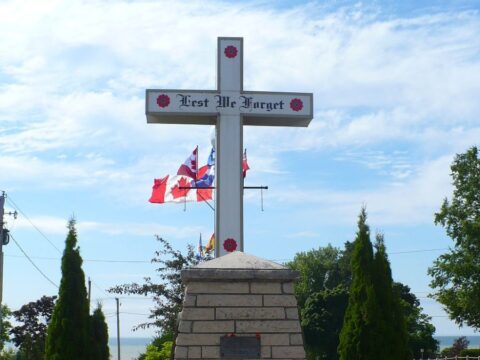Kirk Dunn is an actor, fibre artist and podcast host in Toronto. Over the course of 15 years, he created Stitched Glass, an expansive installation of three hand-knit tapestries styled after stained glass windows, each depicting iconography from one of the three Abrahamic faiths: Judaism, Christianity and Islam. Then, together with his wife, Claire Ross Dunn, he wrote a one-man play about that artistic journey called The Knitting Pilgrim. Since 2019, he has toured the show to churches, theatres and festivals in Ontario, the Maritimes and Europe. The post-performance talkback sessions with his audiences opened up fascinating conversations that inspired Dunn’s latest venture: The Knitting Pilgrim Talks podcast. With curiosity and compassion, Dunn interviews religious leaders on themes ranging from soldiering to Sabbath, always aspiring to deepen interfaith learning and create connections across difference. He spoke to Julie McGonegal in October.
JULIE MCGONEGAL: Could you begin by talking about your spiritual background as a preacher’s kid and how it connects to your work as a knitter?
You may unsubscribe from any of our newsletters at any time.
KIRK DUNN: My experience growing up in the church was very positive. My father’s theology as a Presbyterian minister was inclusive, welcoming and open. And the congregations he was a part of were also very open. I would look at the experiences of friends in other churches or denominations, and they weren’t always having such a good time. My impression of Christianity wasn’t that it was punitive or something that narrowed your choices, but that it opened things up and made them more fun, more enjoyable and more loving.
I think that experience made me want to present a different idea of what church could be to people. I knew that it had to be done by example rather than preaching. The knitting project was something that mattered to me because it was about faith traditions and how they could work together and find common ground.
JM: Knitting has experienced a resurgence in recent years, but you’ve been knitting for a long time. How did you come to embrace it as an artistic practice?
KD: What appealed to me was being able to make something creative — to think that I could turn something into a wearable garment and a beautiful piece of art. I love colours, and I like icons and imagery, so I started designing sweaters incorporating those elements. In 1998, I studied in England with a famous knitter named Kaffe Fassett; he is all about colour.
From there, my wife introduced me to Nataley Nagy, who was then the head of the Textile Museum of Canada in Toronto. She said that I could take my work to the next level by doing installations. That’s where the idea of Stitched Glass came from. I was doing an acting gig in a church, and I remember looking at the stained glass windows and thinking, “Wow, those are such beautiful colours. I would love to be able to knit that!”
This was just after 9/11, and I realized that the Abrahamic religions all have a history of stained glass. I wanted to do a project about how they relate to one another and what they share, as well as look at why they parted ways and the challenges ahead.

JM: How did Stitched Glass birth your one-person play, The Knitting Pilgrim?
KD: Because I was an actor and had no pedigree as a visual artist, I couldn’t get anyone interested in exhibiting Stitched Glass. But I did have some history as a performer, so that was the avenue that was open to me. The show works incredibly well because it is a huge setup for the reveal of these tapestries. Also, in many ways the show itself is a conversation starter. It asks theological questions but doesn’t really give any answers.
We invite people to come up after the performance. I say, “Come on. Let’s have a conversation. You can talk to me. We can talk to each other. And when you go away, I hope you’ll talk to people in your lives as well.”
Some of the feedback we get is, “This is the way theatre should be, because at the end of the show everybody’s talking.”
More on Broadview:
- Singing together makes beautiful music — and social change
- New documentary explores intimate connection between grief and art
- Quilting exhibition celebrates Nova Scotia’s Black communities
JM: You’re continuing to get people talking through your new podcast, which aims to sit in the difficult questions about religion. How did this project come about?
KD: COVID-19 hit. Nothing was happening. So we had this idea of doing a podcast where we could talk to people about each individual section of the tapestries. We started talking to rabbis, imams, ministers, scholars and people in faith communities. I’ve had excellent guests who are certainly willing to sit in the questions. I think we tend to get ourselves into trouble when we want to have things cut and dried.
This project explores the places where we need to give things space and not rush to the answers. Some questions may never be answered. Maybe the point is to have questions to keep returning to, to keep asking ourselves, “Where are we now?”
In looking at all three faiths, I have seen the fantastic common ground that needs to be lifted up and celebrated.
JM: Recently, you had your father, Rev. Zander Dunn, on the show. He spoke about his own non-literalist view of the resurrection of Jesus, and how he has faced reprisals in the church for expressing it. How would you describe your own take on the resurrection story?
KD: Our experience and understanding of the resurrection is mostly an amalgamation of three biblical stories. The point of the resurrection is not how it happened or what the facts of the story were. It’s what it means — that there is life beyond this one.
JM: You began knitting your tapestries in the wake of 9/11, when Islamophobia was rampant. We’re living in polarizing times again, with brutal violence engulfing the Holy Land. Genuine dialogue and listening are vital. How can we widen these practices?
KD: The situation in Israel and Palestine right now is pretty much a no-win. At least for the foreseeable future. All the options I realistically see unfolding are bad. And it’s not just bad for Israel and Hamas — it’s for every- body. Politically, the powers that be, both regionally and globally, are hamstrung by their own politics and don’t seem to be able to do anything nuanced or productive. Lots of black and white, lots of hate, lots of whataboutism and lots of payback.
It must be said that there is no defence for what Hamas did. It was an act of evil, unmitigated terror. At the same time, the Israeli policy in Gaza was not working. It was flawed, it was wrong, and everybody knew it.
That said, maybe because of the polemical mindset that confronts us from both sides, I do think it’s possible to have a helpful discussion. The thing we can do — and I think it’s helpful for all of us, myself included — is to remember that we can hold opposing points of view. Or, rather, we can support both sides, in truth and honesty.
This interview has been edited and condensed for length and clarity.
***
Julie McGonegal is a writer and editor in Guelph, Ont.
This article first appeared in Broadview’s March 2024 issue with the title “Common Threads.”















